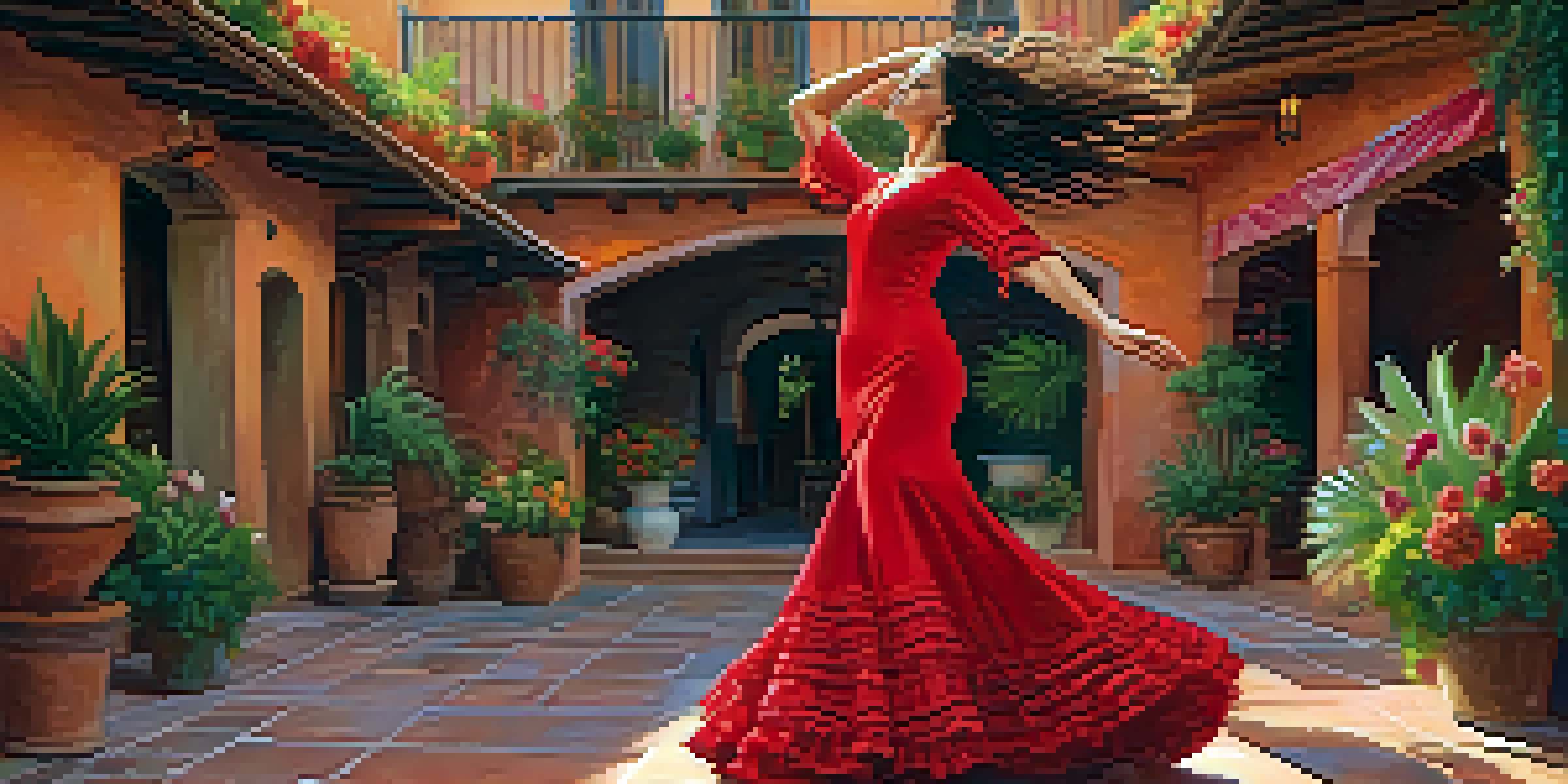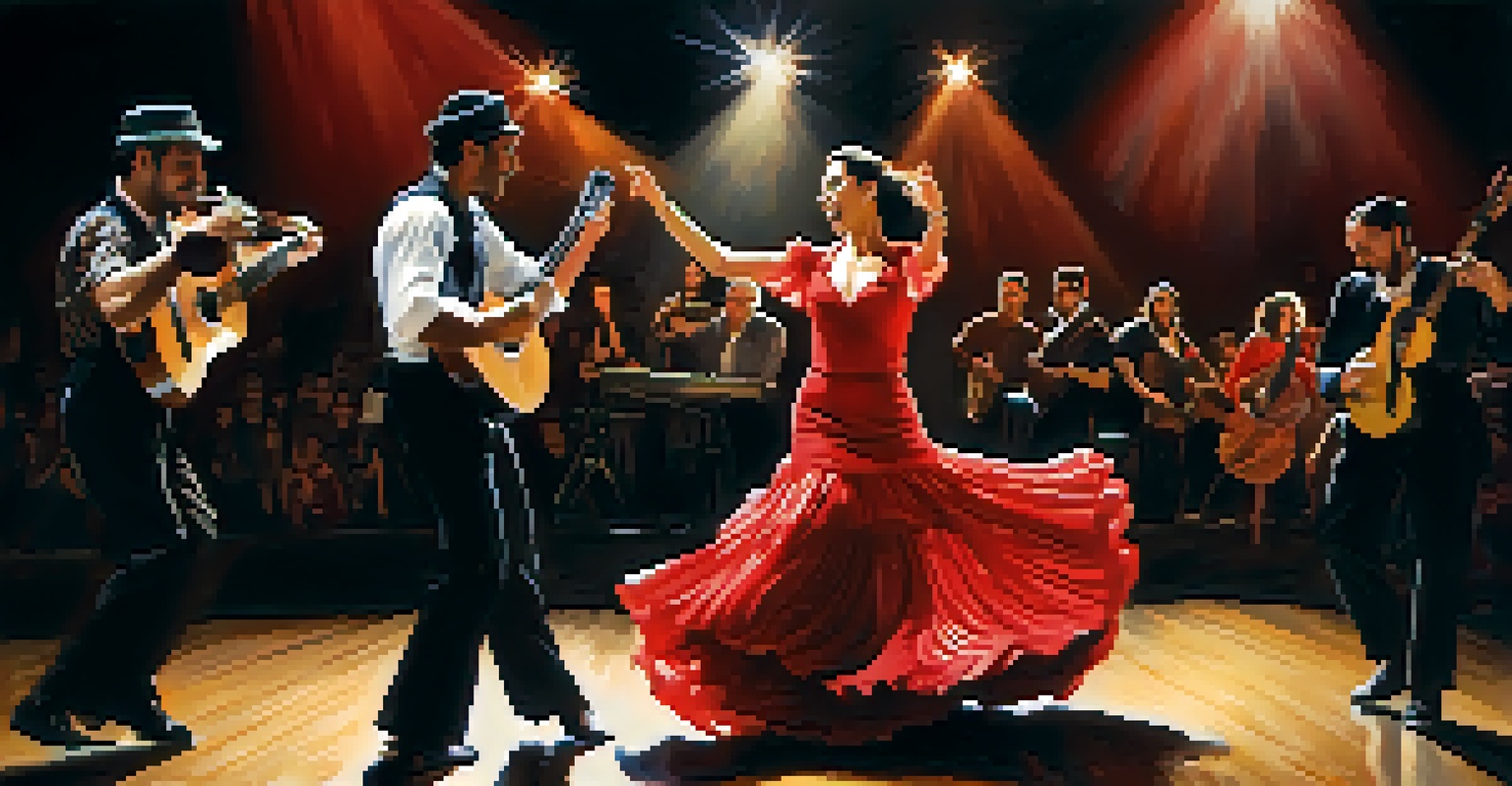Understanding Flamenco: A Blend of Cultures and Traditions

The Origins of Flamenco: A Cultural Confluence
Flamenco has deep roots in the Andalusian region of Spain, where diverse cultures have mingled for centuries. Its origins can be traced back to the fusion of various influences, including the Gypsies, Moors, and Jews, each contributing unique elements to the art form. This blend created a musical style that is rich in emotional expression and cultural significance, embodying the heart and soul of the Spanish people.
Flamenco is not just a dance; it is a way of expressing the anguish and joy of life.
The term 'Flamenco' itself is believed to have originated from the Arabic word 'felag-mengu,' which means 'fugitive.' This reflects the nomadic lifestyle of many of the cultures involved, especially the Romani people. As these communities traveled, they shared their music and dance, leading to the vibrant Flamenco we know today, characterized by its passionate rhythms and intricate footwork.
Understanding Flamenco begins with recognizing this cultural confluence, where the music and dance serve as a powerful reminder of the shared histories that define the region. The art form not only entertains but also tells the stories of those who came before, making it a living testament to the resilience and creativity of the human spirit.
The Elements of Flamenco: Music, Dance, and Song
Flamenco is a dynamic art form that encompasses three primary elements: cante (singing), toque (guitar playing), and baile (dance). Each component plays a crucial role in creating the emotional depth and complexity that Flamenco is known for. The interplay between these elements is what makes a Flamenco performance truly captivating, as they complement and enhance one another.

Cante, or singing, is often considered the heart of Flamenco. It conveys the intense emotions of joy, sorrow, and longing, using a unique vocal style that often includes intricate ornamentation. The lyrics frequently draw from themes of love, loss, and the struggles of everyday life, resonating deeply with audiences.
Flamenco's Cultural Roots
Flamenco originated from a rich blend of diverse cultures in Andalusia, including the Gypsies, Moors, and Jews, contributing to its emotional depth and cultural significance.
Toque, the guitar playing, adds a rich layer of sound that supports the cante and baile. Flamenco guitarists have developed a distinctive style characterized by rapid fingerpicking and percussive strumming. Finally, the baile, or dance, showcases the physical expression of these emotions, featuring intricate footwork and expressive body movements that tell a story all their own.
The Role of Emotion in Flamenco Performance
At the core of Flamenco lies an intense emotional expression known as 'duende.' This term refers to the spirit or soul of the performance, capturing the raw emotions that resonate with both the performer and the audience. When a Flamenco artist connects with their duende, the performance transcends mere entertainment, becoming a profound experience that evokes empathy and understanding.
The essence of Flamenco is in its ability to convey deep emotion and tell stories that resonate with the human experience.
The concept of duende is often likened to the idea of a spark or a flame that ignites passion and creativity. It can be felt in the way a singer pours their heart into a cante or how a dancer's movements convey deep emotional narratives. This connection is what makes Flamenco performances so impactful, as they resonate on a personal level with those who experience them.
Understanding the role of emotion in Flamenco allows audiences to appreciate the depth of the art form. It's not just about the technical skill; it's about the feeling that each artist brings to the stage, creating a shared moment of connection that lingers long after the performance is over.
The Influence of Gypsy Culture on Flamenco
The Romani people, often referred to as Gypsies, have played a pivotal role in shaping Flamenco into the vibrant art form it is today. Their unique cultural heritage and rich musical traditions heavily influenced Flamenco's development, particularly through their passionate singing and storytelling techniques. This influence is evident in the way Flamenco music and dance often reflect themes of longing and freedom.
Gypsy musicians and dancers were among the first to perform Flamenco in its early days, bringing their own style and flair to the art form. Their performances often showcased a blend of different musical traditions, incorporating elements from Eastern Europe, North Africa, and the Middle East. This fusion added layers of complexity and richness to Flamenco, making it an ever-evolving art form.
Emotional Expression in Performance
The concept of 'duende' captures the intense emotional expression in Flamenco, allowing performers to connect deeply with audiences through their art.
Today, the legacy of Gypsy culture continues to be celebrated within Flamenco, as many artists proudly identify their heritage. This connection not only honors the past but also ensures the continued evolution of Flamenco, as new generations embrace and reinterpret its traditions.
Flamenco and Its Global Impact
Flamenco's influence extends far beyond the borders of Spain, capturing the hearts of people around the world. The art form has inspired countless artists, musicians, and dancers, leading to a global appreciation for its unique blend of cultures and traditions. As a result, Flamenco has become a symbol of cultural exchange, bridging gaps between different communities and fostering understanding.
In recent years, Flamenco festivals and workshops have popped up in various countries, inviting people from diverse backgrounds to experience this captivating art form. These events not only showcase traditional Flamenco performances but also encourage collaboration between artists from different genres, creating innovative fusions that keep the art form fresh and relevant.
The global impact of Flamenco serves as a reminder of the power of cultural exchange. As artists worldwide continue to explore and adapt Flamenco, they honor its rich history while also paving the way for new interpretations and expressions that resonate with contemporary audiences.
Preserving Flamenco: Challenges and Efforts
Despite its popularity, Flamenco faces challenges in preservation and authenticity. As the art form has evolved, concerns have arisen regarding the dilution of traditional styles in favor of commercialization. This tension between maintaining authenticity and embracing innovation is a delicate balance that many artists navigate.
Efforts to preserve Flamenco's traditional roots include initiatives by cultural organizations and educational institutions. These programs aim to educate new generations about Flamenco's history, techniques, and cultural significance, ensuring that the art form continues to thrive. Workshops, classes, and performances help keep the passion for Flamenco alive among both participants and audiences.
Global Influence and Adaptation
Flamenco has transcended borders, inspiring artists worldwide while also evolving through innovative fusions with other musical genres.
Moreover, the recognition of Flamenco as an Intangible Cultural Heritage by UNESCO in 2010 has significantly contributed to its preservation. This acknowledgment not only highlights the importance of Flamenco but also encourages efforts to sustain its traditions, fostering a greater appreciation for the art form on a global scale.
The Future of Flamenco: Evolution and Adaptation
Looking ahead, the future of Flamenco appears bright as artists continue to explore new avenues for expression. The fusion of Flamenco with other musical genres, such as jazz, pop, and even hip-hop, has opened up exciting possibilities for innovation. This evolution allows Flamenco to remain relevant while still honoring its rich traditions.
Young artists are at the forefront of this movement, experimenting with different styles and incorporating contemporary themes into their performances. By blending traditional elements with modern influences, they create a fresh take on Flamenco that resonates with diverse audiences. This adaptability is crucial for the art form's continued growth and relevance in today's world.

As Flamenco evolves, it will undoubtedly face challenges along the way. However, the passion and dedication of artists committed to preserving its essence while embracing change ensure that Flamenco will continue to captivate hearts and minds for generations to come.